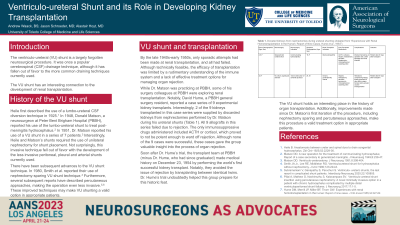Ventriculo-ureteral Shunt and its Role in Developing Kidney Transplantation
Ventriculo-ureteral Shunt and Its Role in Developing Kidney Transplantation
Friday, April 21, 2023


Andrew L. Waack, BS
Medical Student
University of Toledo College of Medicine and Life Sciences
Holland, Ohio, United States
ePoster Presenter(s)
Introduction: The ventriculo-ureteral (VU) shunt is a largely obsolete method of managing hydrocephalus. However, this nearly-forgotten neurosurgical procedure is of historical interest, as it played an important role in the development of kidney transplantation.
Methods: Historical vignette linking the VU shunt to the development of kidney transplantation.
Results: The ventriculo-ureteral (VU) shunt is a little-known method of shunting cerebrospinal fluid directly into the ureter. It is very rarely performed in modern settings. Although it does not provide much utility to the contemporary neurosurgeon, it is interesting to note the role this procedure played in the development of kidney transplantation. In the late 1940s - early 1950s, Donald Matson, a pediatric neurosurgeon at the Peter Bent Brigham Hospital, was using the VU shunt for his patients Notably, Dr. Matson’s VU shunt technique involved total nephrectomy of a healthy kidney. Concurrently, David Hume and colleagues at the Peter Bent Brigham Hospital, were undertaking a series of human kidney transplantations. Several of the kidneys harvested during Dr. Matson’s VU shunt nephrectomies were donated to Dr. Hume for use in his transplantation trials. Although none of the transplanted kidneys from this series were successful, the transplant team in Boston, minus David Hume, went on to perform the world’s first kidney transplant a few years later.
Conclusion : The VU shunt is a largely abandoned neurosurgical procedure that played a role in the development of renal transplantation.
Methods: Historical vignette linking the VU shunt to the development of kidney transplantation.
Results: The ventriculo-ureteral (VU) shunt is a little-known method of shunting cerebrospinal fluid directly into the ureter. It is very rarely performed in modern settings. Although it does not provide much utility to the contemporary neurosurgeon, it is interesting to note the role this procedure played in the development of kidney transplantation. In the late 1940s - early 1950s, Donald Matson, a pediatric neurosurgeon at the Peter Bent Brigham Hospital, was using the VU shunt for his patients Notably, Dr. Matson’s VU shunt technique involved total nephrectomy of a healthy kidney. Concurrently, David Hume and colleagues at the Peter Bent Brigham Hospital, were undertaking a series of human kidney transplantations. Several of the kidneys harvested during Dr. Matson’s VU shunt nephrectomies were donated to Dr. Hume for use in his transplantation trials. Although none of the transplanted kidneys from this series were successful, the transplant team in Boston, minus David Hume, went on to perform the world’s first kidney transplant a few years later.
Conclusion : The VU shunt is a largely abandoned neurosurgical procedure that played a role in the development of renal transplantation.
